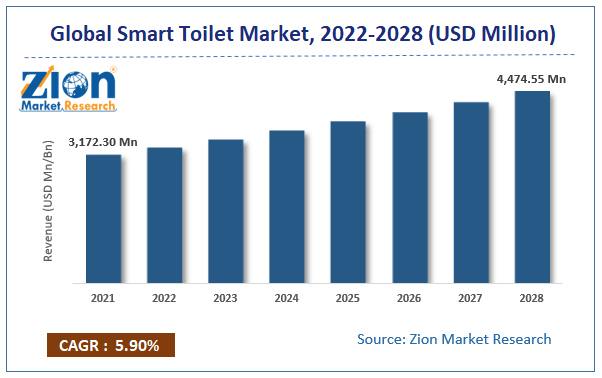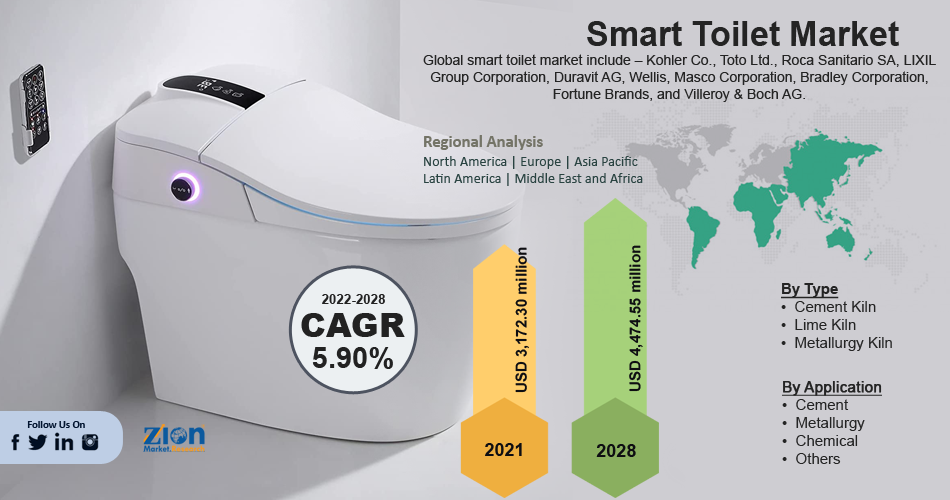Global Smart Toilet Market Size, Share, Growth Analysis Report - Forecast 2034

Smart Toilet Market By Type (Wall-Hung Toilet, Close-Coupled, Single Floor Standing Toilet, One-Piece Toilet, Others), By Category (Integrated Smart Toilet, Smart Toilet Seats), Connectivity (Wi-Fi, Bluetooth, Remote Control), Application (Residential, Commercial), Distribution Channel (Offline, Online), and By Region: Global and Regional Industry Overview, Market Intelligence, Comprehensive Analysis, Historical Data, and Forecasts 2025 - 2034
| Market Size in 2024 | Market Forecast in 2034 | CAGR (in %) | Base Year |
|---|---|---|---|
| USD 10.75 Billion | USD 34.42 Billion | 12.34% | 2024 |
Smart Toilet Market: Industry Perspective
The global smart toilet market size was worth around USD 10.75 Billion in 2024 and is predicted to grow to around USD 34.42 Billion by 2034 with a compound annual growth rate (CAGR) of roughly 12.34% between 2025 and 2034. The report analyzes the global smart toilet market's drivers, restraints/challenges, and the effect they have on the demands during the projection period. In addition, the report explores emerging opportunities in the smart toilet industry.
Smart Toilet Market: Overview
The smart toilet is a smart toilet device that opens and closes automatically. This smart toilet features several advanced sensor technologies that allow users to customize every detail, from warm water cleaning, UV disinfection, heated seats, and hands-free seat closing to automatic flushing ambient lighting and air freshener. In addition, smart toilets include hardware components such as sprinklers, bottom scrubbers, hair dryers, and artificial flushing sounds to mask the noise. Some smart toilets have built-in smart virtual assistants that allow users to create an ideal environment using just their voice. These toilets can also be connected to mobile apps that will enable users the freedom to set their personal preferences, such as preferred temperature, cleaning pressure, and status for each person in a household. Growing consumer demand for convenience hygiene products is expected to remain a driving factor in the market growth in the coming years. In addition, industry participants offer innovative hygiene technologies, including UV lighting, automatic flushing, Bluetooth connectivity, and auto-opening seat covers to provide an excellent bathroom experience for consumers.
Key Insights
- As per the analysis shared by our research analyst, the global smart toilet market is estimated to grow annually at a CAGR of around 12.34% over the forecast period (2025-2034).
- Regarding revenue, the global smart toilet market size was valued at around USD 10.75 Billion in 2024 and is projected to reach USD 34.42 Billion by 2034.
- The smart toilet market is projected to grow at a significant rate due to rising focus on hygiene and convenience, increasing smart home adoption, technological innovations (e.g., sensors, automation), and aging population needs.
- Based on Type, the Wall-Hung Toilet segment is expected to lead the global market.
- On the basis of Category, the Integrated Smart Toilet segment is growing at a high rate and will continue to dominate the global market.
- Based on the Connectivity, the Wi-Fi segment is projected to swipe the largest market share.
- By Application, the Residential segment is expected to dominate the global market.
- In terms of Distribution Channel, the Offline segment is anticipated to command the largest market share.
- Based on region, Asia-Pacific is predicted to dominate the global market during the forecast period.
Smart Toilet Market: Growth Drivers
The growing demand for water-saving technology aids the global market growth
The growing demand for water-saving technology is driving the global smart toilet market. One of the main goals of leading smart toilet manufacturers is to conserve water and water resources. Population growth has increased the need for water sustainability, increasing the need for water conservation. Smart toilets effectively contribute to water conservation. Smart water-saving toilets help save total water consumption for each household. The growing demand for water-saving technology is expected to drive the growth of the global smart toilet market.
Smart Toilet Market: Restraints
The availability of substitutes may hamper the global market growth
The threat of substitute products challenges the smart toilet market. Conventional toilets are often favored in countries like China, India, and other developing countries. The lack of awareness of smart toilet features cost constraints, and low penetration in developing countries are expected to hinder the future smart toilet market’s growth. In addition, hygiene culture varies from country to country. Demand for smart toilets is limited to high-income groups and high-end commercial buildings.
Smart Toilet Market: Opportunities
The benefits of smart toilets bring up several growth opportunities
Smart toilets offer significant benefits with a range of efficiency sensors built into their systems, such as automatic flushing and the ability to detect the amount of water needed to complete a single pass discharge. This feature reduces water usage compared to conventional toilets and automatically shuts off when a potential overflow is detected, leaks, and smart device alerts, saving utility costs. These products can optimize water and electrical energy consumption, making them a hygienic and practical option for buyers. Smart toilets can open and close automatically, heat up, and even clean and deodorize. It can be seen that the installation of smart bathroom products has become a style statement. These factors, coupled with rapid economic growth and improvement of lifestyles worldwide, are expected to act as a significant headwind for the global smart toilet market. All these factors will present considerable opportunities for market growth during the forecast period. In addition, emerging markets globally will give untapped opportunities for an integrated smart toilet market.
Smart Toilet Market: Segmentation
The global smart toilet market is segregated based on application, distribution channel, and region.
By application, the market is divided into residential and commercial. Among these, the commercial segment dominates the market, accounting for a significant percentage of global sales due to many high-end restaurants, bars, hotels, and shopping malls installing smart toilets to provide cleaning services to their customers. Furthermore, smart toilets are considered a premium product installed in high-end commercial places.
By distribution channel, the market is bifurcated into online and offline. Over the forecast period, the offline distribution channels were the largest segment with significant revenue in 2020. Many consumers prefer to buy smart products from these channels because they provide a selection—of fact checks before making any purchase decision. In addition, various residential and commercial real estate companies partner with these stores to ensure the continued offering of discounted products.
Recent Developments
- November 2021 - Kohler, America's leading bathroom furniture and plumbing supplier teamed up with Daniel Arsham to create a 3D printed sink. During Milan Design Week 2022, Kohler showcased new digital bathroom solutions alongside Daniel Arsham's immersive artwork.
- January 2021- Toto Ltd., the world's largest Japanese toilet manufacturer, has launched a "health care toilet" based on artificial intelligence (AI). Wellness Toilet monitors and analyzes the user's mental and physical state using various advanced sensor technologies. This data provides health improvement recommendations on the smartphone app to users.
Smart Toilet Market: Report Scope
| Report Attributes | Report Details |
|---|---|
| Report Name | Smart Toilet Market |
| Market Size in 2024 | USD 10.75 Billion |
| Market Forecast in 2034 | USD 34.42 Billion |
| Growth Rate | CAGR of 12.34% |
| Number of Pages | 254 |
| Key Companies Covered | Kohler Co., Toto Ltd., Xiaomi Corporation, Roca Sanitario SA, LIXIL Group Corporation, Duravit AG, Wellis, Masco Corporation, Villeroy & Boch AG, Jomoo Group, and others. |
| Segments Covered | By Type, By Category, By Connectivity, By Application, By Distribution Channel, and By Region |
| Regions Covered | North America, Europe, Asia Pacific (APAC), Latin America, The Middle East and Africa (MEA) |
| Base Year | 2024 |
| Historical Year | 2020 to 2024 |
| Forecast Year | 2025 to 2034 |
| Customization Scope | Avail customized purchase options to meet your exact research needs. Request For Customization |
Smart Toilet Market: Regional Landscape
The new construction projects help Europe dominate the global market
Europe holds the dominant share of the global smart toilet market and is expected to maintain its leadership position throughout the forecast period. In 2020, this region accounted significant market share. Factors such as increasing consumer spending on maintaining bathroom hygiene and improving purchases of smart toilets are driving the region’s market. Many people in the UK and Germany prefer touchless smart toilets. In addition, increased spending on hygiene and health products in Germany, the UK, and France is a favorable factor for increasing the smart toilet market size.
Smart Toilet Market: Competitive Analysis
The report provides a company market share analysis to give a broader overview of the key market players. In addition, the report also covers key strategic developments of the market, including acquisitions & mergers, new product launches, agreements, partnerships, collaborations & joint ventures, research & development, and regional expansion of major participants involved in the smart toilet market on a global and regional basis.
The global smart toilet market is dominated by players like:
- Kohler Co.
- Toto Ltd.
- Xiaomi Corporation
- Roca Sanitario SA
- LIXIL Group Corporation
- Duravit AG
- Wellis
- Masco Corporation
- Villeroy & Boch AG
- Jomoo Group
The global smart toilet market is segmented as follows;
By Type
- Wall-Hung Toilet
- Close-Coupled
- Single Floor Standing Toilet
- One-Piece Toilet
- Others
By Category
- Integrated Smart Toilet
- Smart Toilet Seats
By Connectivity
- Wi-Fi
- Bluetooth
- Remote Control
By Application
- Residential
- Commercial
By Distribution Channel
- Offline
- Online
By Region
- North America
- The U.S.
- Canada
- Mexico
- Europe
- France
- The UK
- Spain
- Germany
- Italy
- Rest of Europe
- Asia Pacific
- China
- Japan
- India
- Australia
- South Korea
- Rest of Asia Pacific
- The Middle East & Africa
- Saudi Arabia
- UAE
- Egypt
- Kuwait
- South Africa
- Rest of the Middle East & Africa
- Latin America
- Brazil
- Argentina
- Rest of Latin America
Table Of Content
Methodology
FrequentlyAsked Questions
The global smart toilet market is expected to grow due to rising hygiene awareness, technological innovation in home automation, and growing demand for luxury and aging-friendly bathroom solutions.
According to a study, the global smart toilet market size was worth around USD 10.75 Billion in 2024 and is expected to reach USD 34.42 Billion by 2034.
The global smart toilet market is expected to grow at a CAGR of 12.34% during the forecast period.
Asia-Pacific is expected to dominate the smart toilet market over the forecast period.
Leading players in the global smart toilet market include Kohler Co., Toto Ltd., Xiaomi Corporation, Roca Sanitario SA, LIXIL Group Corporation, Duravit AG, Wellis, Masco Corporation, Villeroy & Boch AG, Jomoo Group, among others.
The report explores crucial aspects of the smart toilet market, including a detailed discussion of existing growth factors and restraints, while also examining future growth opportunities and challenges that impact the market.
RelatedNews
HappyClients
Zion Market Research
Tel: +1 (302) 444-0166
USA/Canada Toll Free No.+1 (855) 465-4651
3rd Floor,
Mrunal Paradise, Opp Maharaja Hotel,
Pimple Gurav, Pune 411061,
Maharashtra, India
Phone No +91 7768 006 007, +91 7768 006 008
US OFFICE NO +1 (302) 444-0166
US/CAN TOLL FREE +1 (855) 465-4651
Email: sales@zionmarketresearch.com
We have secured system to process your transaction.
Our support available to help you 24 hours a day, five days a week.
Monday - Friday: 9AM - 6PM
Saturday - Sunday: Closed






